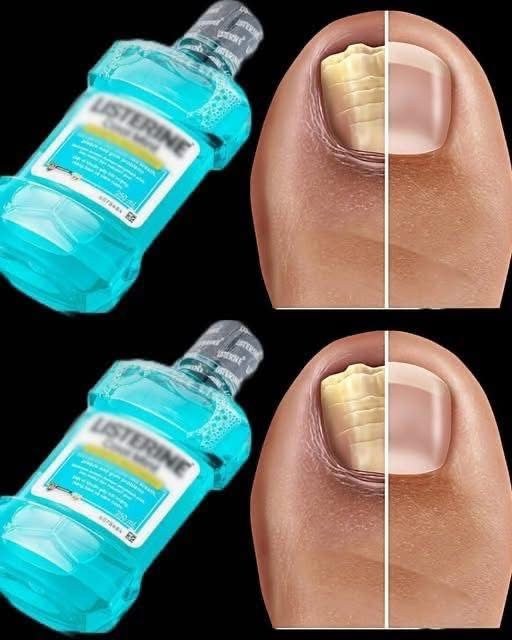Nail fungus is one of those health problems that seems minor until you’re the one dealing with it. It starts as a small change—a yellow spot under the nail, a little thickening, maybe a brittle edge. Left untreated, though, it spreads, warps the nail, and makes even simple things like putting on socks uncomfortable. Millions worldwide battle this stubborn condition, and for many, the frustration lies not only in how unsightly it looks but also in how difficult and expensive it can be to treat. While pharmacies are packed with antifungal creams, tablets, and nail solutions, they often take months to show results, and not everyone wants to rely on prescription drugs. That’s where a surprisingly simple, inexpensive home remedy comes in—mouthwash.
It sounds almost absurd at first. Mouthwash is meant to freshen your breath, not heal your toenails. But look past the branding, and you’ll see why this solution actually makes sense. The same compounds that help kill bacteria in the mouth—eucalyptol, menthol, and thymol—are also known antifungal agents. Add in the alcohol content most mouthwashes contain, and you’ve got a liquid that’s naturally equipped to disinfect and attack the fungi causing nail infections. It’s not just internet folklore; there’s logic in using an antiseptic rinse on a fungal issue.
So how exactly does it work? Nail fungus thrives in dark, damp conditions where ordinary soap and water can’t fully penetrate. The antifungal and antiseptic compounds in mouthwash can seep into cracks around and under the nail, disrupting the fungus’s growth and, over time, killing it. The alcohol dries out the environment fungi depend on, making it harder for the infection to spread. Unlike some harsh chemicals, mouthwash is formulated for use inside the human body, meaning it’s generally safe for external application on nails and skin.
Using mouthwash as a nail fungus remedy doesn’t require anything complicated. One common approach is to soak the affected nails in a small basin filled with mouthwash for 15 to 20 minutes a day. Some people mix equal parts mouthwash and vinegar, as vinegar itself is acidic and helps fight fungal infections. Others dab mouthwash directly onto the nail with a cotton ball several times daily. The key here is consistency—nail fungus doesn’t clear overnight, no matter the treatment. But with steady use, mouthwash can help reduce discoloration, soften thickened nails, and prevent the infection from spreading to other toes or fingers.
Compared to prescription antifungal drugs, which can come with side effects like liver stress or digestive upset, mouthwash is inexpensive, accessible, and low-risk for most people. A large bottle costs just a few dollars, and chances are you already have some sitting in your bathroom cabinet. That makes it an appealing option for those who want a natural first line of defense or a complementary treatment alongside more traditional options.
Of course, there are caveats. Not every case of nail fungus will respond to mouthwash, especially if the infection is severe or has spread beneath multiple nails. Fungi can be stubborn, and sometimes professional medical treatment is unavoidable. It’s also important to remember that while mouthwash may help kill fungus on the surface and around the nail, nails grow slowly. It can take months for a healthy new nail to replace the damaged one, even if the fungus has been wiped out. Patience is part of the process.
There are also preventive lessons here. Fungal nail infections thrive in warm, moist environments—public showers, sweaty shoes, swimming pools. Regularly washing and thoroughly drying your feet, wearing breathable footwear, and trimming nails properly can dramatically cut down the risk of infection. If you’ve already cleared an infection, these habits help ensure it doesn’t return. Adding a weekly mouthwash soak as a preventive measure isn’t a bad idea either.
Think about it: a simple household product, originally designed for dental hygiene, doubling as an antifungal treatment. It’s a reminder that sometimes the best remedies are sitting right in front of us, disguised as something else entirely. While science is still catching up on just how effective mouthwash is against nail fungus in clinical trials, countless anecdotal success stories suggest it’s worth a try before investing in pricier, more invasive treatments.
In the end, nail fungus may be stubborn, but it doesn’t always need to be a wallet-draining or emotionally exhausting battle. With persistence, creativity, and a little bit of antiseptic mouthwash, you might just find that the solution was hiding in plain sight all along.



